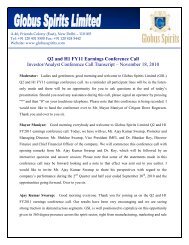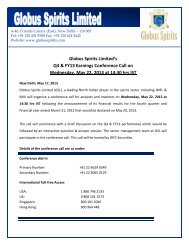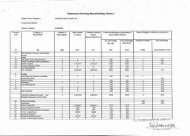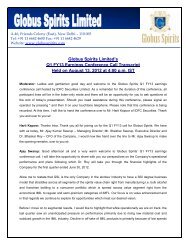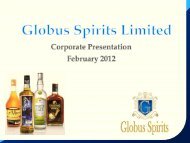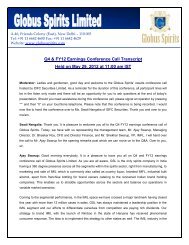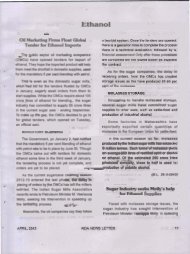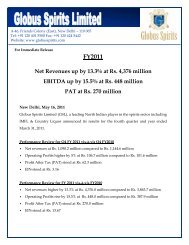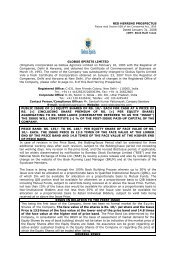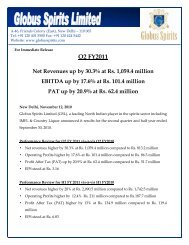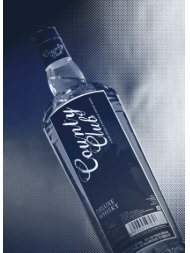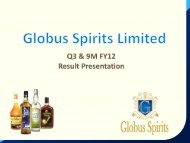RED HERRING PROSPECTUS Dated August 24 ... - Globus Spirits
RED HERRING PROSPECTUS Dated August 24 ... - Globus Spirits
RED HERRING PROSPECTUS Dated August 24 ... - Globus Spirits
Create successful ePaper yourself
Turn your PDF publications into a flip-book with our unique Google optimized e-Paper software.
groups in urban areas. IMFL is consumed by the middle and high income groups, primarily in<br />
urban areas.<br />
As was found to be the case with beer; so it is with whisky. Increasingly more and more of the<br />
major international liquor companies are introducing new brands in India through local joint<br />
venture arrangements. These include the following new whisky brands:<br />
• Allied Domeq with Clan Morgan & Co to produce Teachers Brand Scotch Whiskies.<br />
• IDV (Grand Met.) with Polychem Limited to produce Spey Royal Scotch Whiskey.<br />
• United distillers with U.B.Group to produce Black & White, Blend 69, Black Dog & Vat 69.<br />
• Seagram with Seagram India to produce Something Special, 100 Pipers Scotch Whiskey.<br />
• McDonald & Muir with Mohan Meakins to produce Highland Queen Scotch Whiskey.<br />
• White spirits are considered by many observers to be the next major growth sector.<br />
(Source: Ministry of Food Processing Industries, Government of India;<br />
http://mofpi.nic.in/industryspecificinformation)<br />
Wine<br />
It is only very recently that wine has begun to be produced on a significant scale in India. Its<br />
production takes place in both the organised and the household sectors. Sparkling wine is also<br />
manufactured in India. However, this is intended for the export market and the volumes<br />
involved are small. (Source: Ministry of Food Processing Industries, Government of India;<br />
http://mofpi.nic.in/industryspecificinformation)<br />
In growth terms an IWSR Report, 2006, noted that the wine industry in India was growing at<br />
25-30% annually as compared to the 7-8% growth in China and 2-3% worldwide. Across India,<br />
out-of home consumption is on the rise, which is important for the wine industry. Pubs, bars,<br />
restaurants and five-star hotels are the primary wine selling outlets with 63% of sales volume<br />
coming from these channels.<br />
But compared to the rest of Asia, the percentage of wine consumption in India is still low. IWSR<br />
2006 reported that ‘India accounted for 0.8% of the total wine consumption in Asia as compared<br />
to China, which accounts for more than 62.7% market share’. More than 80% consumption<br />
remains confine to metros – Mumbai 39%, Delhi 23%, Bangalore 9% and Goa 9%.<br />
Market Characteristics<br />
• Preference for brown spirits (molasses flavour) in Indian market<br />
• Liquor packed in 180, 375, 500, 750 and 1000 ML bottles - glass and plastic bottles. 180 ML<br />
and 750 ML are fast moving<br />
• Guala caps on bottles to prevent bootlegging<br />
• Brand building very important<br />
• Yet avenues limited - advertising of liquor banned in most media<br />
• Promotions, sponsorships, surrogate advertising (sometimes) done to build brands<br />
State Specific Business<br />
a) India is marked with state-specific business situation, which is most unlikely to change<br />
rapidly, or in the medium-term, and possibly not at all, because:<br />
b) Liquor is a vital element in each state’s revenue.<br />
c) The states strongly resist Central Government dictated changes.<br />
d) There is a strong philosophical and/or religious hostility to alcohol among many states’<br />
voters.<br />
e) In 1995, Andhra Pradesh voted in a government that promised and enforced prohibition and<br />
very cheap rice. By end 1996, it was bankrupt and lifted prohibition in mid 1997. Haryana<br />
also enforced prohibition from July 1996, but abandoned it in April 1998. Criminality boomed<br />
in these periods.<br />
f) Changing laws or reducing taxes on alcohol is never a vote winner; and is, therefore,<br />
avoided.<br />
g) Most states raised liquor taxes from 1994 onwards, with a pause in 1995, but 1997 saw<br />
more increases, particularly in the key Maharashtra market, where the state claimed to have<br />
increased its revenue from alcohol in 1997. Since then Maharashtra has taken a more<br />
moderate view in order to conserve revenue.<br />
(Source: The IWSR 2006 Report; Date of Publication March 2006)<br />
67




